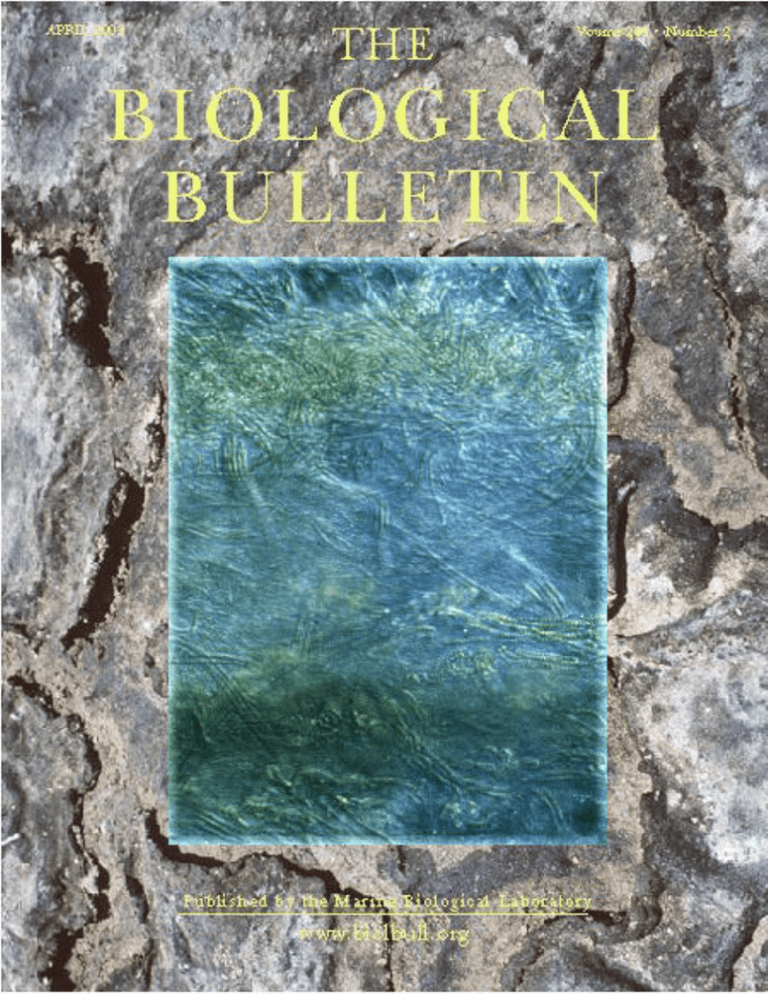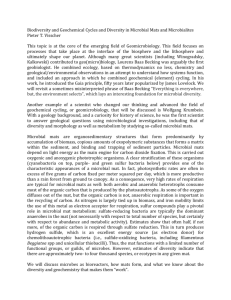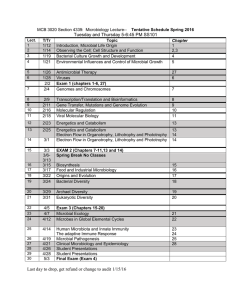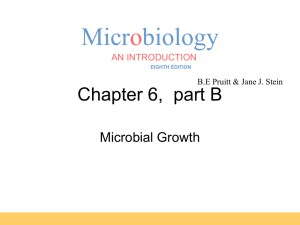Document 13386107
advertisement

Reference: Biol. Bull. 204: 168 –173. (April 2003) © 2003 Marine Biological Laboratory Complexity in Natural Microbial Ecosystems: The Guerrero Negro Experience JOHN R. SPEAR, RUTH E. LEY, ALICIA B. BERGER, AND NORMAN R. PACE* Department of Molecular, Cellular and Developmental Biology, University of Colorado, Boulder, 347 UCB, Boulder, Colorado 80309 The goal of this project is to describe and understand the organismal composition, structure, and physiology of microbial ecosystems from hypersaline environments. One collection of such ecosystems occurs at North America’s largest saltworks, the Exportadora de Sal, in Guerrero Negro, Baja California Sur. There, seawater flows through a series of evaporative basins with an increase in salinity until saturation is reached and halite crystallization begins. Several of these ponds are lined with thick (10 cm) microbial mats that have received some biological study. To determine the nature and extent of diversity of the microbial organisms that constitute these ecosystems, we are conducting a phylogenetic analysis using molecular approaches, based on cloning and sequencing of small subunit (SSU) rRNA genes (16S for Bacteria and Archaea, 18S for Eukarya). In addition, we report preliminary results on the microbial composition of a laminated community that occurs in a crystallized gypsum-halite matrix in near-saturated salt water. Exposure of the interior of these large (kilogram) wet, endoevaporite crystals reveals a multitude of colors: layers of yellow, green, pink, and purple microbiota. To date, analyses of these two environments indicate the ubiquitous dominance of uncultured organisms of phylogenetic kinds not generally thought to be associated with hypersaline environments. The Endoevaporite Study The goals for this portion of the study were to examine the nature of life in the “extreme” environment of an endoevaporite (endo-life within, evaporite-sedimentary rock of precipitating salt deposits), add to what is known about life and where it exists on Earth, and test the application of molecular phylogenetic methods in hypersaline communities. Evaporative salt deposits (evaporites) that contain halite (NaCl), gypsum (CaSO4 䡠 2H2O), or anhydrite (CaSO4) are widespread, and are well known in the rock record. These hypersaline conditions are considered by humans to be a “harsh” environment for life (Stolz, 1990; Rothschild et al., 1994; Litchfield, 1998). Evaporites develop by crystallization from brine of at least 30 g/l NaCl. They are formed by platy deposition of one or more of these minerals in the saturated zone. Expansive pressure from crystal growth within the deposits can break up the plate, producing irregular plates that break the air-water interface and give rise to fins, or teepees (Warren, 1988, 1999). These teepees can extend tens of centimeters above the brine. Teepees of gypsum are porous, and that porosity determines the nature of the endoevaporite, since air, water (brine), and light all have potential for zonation relevant for microbial life. Depending on the crystals present (e.g., halite or gypsum), incoming solar irradiation is heavily attenuated by the translucent crystal lattice. This creates different zones of filtered sunlight where distinct microbial communities can reside (Oren et al., 1995; Vreeland and Powers, 1999). Gypsum needles and clear halite crystals can both act as “light pipes” to diffuse light farther into the evaporative crystal than surface-sun exposure alone. The incoming sunlight is filtered by the crystal matrix to longer wavelengths at greater depth into an endoevaporite. The light may be less accessible to the surface as permeability in the structure changes, porosity decreases, *To whom correspondence should be addressed. E-mail: nrpace@ colorado.edu The paper was originally presented at a workshop titled Outcomes of Genome-Genome Interactions. The workshop, which was held at the J. Erik Jonsson Center of the National Academy of Sciences, Woods Hole, Massachusetts, from 1-3 May 2002, was sponsored by the Center for Advanced Studies in the Space Life Sciences at the Marine Biological Laboratory, and funded by the National Aeronautics and Space Administration under Cooperative Agreement NCC 2-1266 168 169 COMPLEXITY IN A MICROBIAL ECOSYSTEM and permeability changes during early diagenesis (Warren, 1988, 1999). The endoevaporites used in this study were obtained from the gypsum flats on the south end of the Pond 9 crystallization basin at the Exportadora de Sal, in Guerrero Negro, Baja California Sur. Hectares of teepee-like structures rise out of this saturated gypsum crust and are clearly visible. When pieces of teepees are broken off and viewed in cross section, laminated colors are apparent. The surface exposed to the sun has a white or brown salt crystal color; a bright yellow, 1-cm-thick layer is next; followed by a 1-cm-thick green layer; then a 1-cm-thick pink-to-purple layer; and finally a black core in the interior of the crystals. Light microscopy of these layers shows that most of the cells are either in the pore spaces between salt crystals or enveloping the crystals, possibly as complex biofilms. Little is known about how the microbial colonization of the evaporite occurs. Potential mechanisms presumably are cellular transport by incoming seawater via pond flow; groundwater infiltration; air transport and deposition, and animal transport and deposition. X-ray diffraction studies of these particular crystals have revealed that the outer layers of the evaporite—the yellow and green layers—, are primarily composed of gypsum, with a trace of halite. The pink layer and the inner core are primarily halite. This stratification indicates that different microbes are responsible for the colors. This study then asks several questions: Are there few or many different kinds of microbes present? Is this the province of Archaea—thought to be the more “extreme” of the three domains of life? What kinds of life can thrive in this “extreme” environment? Does photosynthesis provide primary productivity for the entire community? Does the microbiota contribute to crystal formation? The basic methods employed in this study involved the determination of ribosomal RNA sequences present in the ecosystems. Samples were acquired in the field and transported to the laboratory, where community genomic DNAs were isolated. Amplification by PCR with various universal and domain-specific primers for the 16S or 18S rRNA gene was followed by cloning of the product to separate individual rRNA genes. This process provided a library of signatures, the rRNA sequences or “phylotypes,” for the organisms that compose the communities (for methods see Reysenbach et al., 1994; Pace, 1997, 2001; Hugenholtz et al., 1998a, b). Although this molecular approach to the identification of the makeup of natural ecosystems is complex and fraught with complications, it has afforded the first glimpse of environmental diversity without culturing the organisms. Results to date have revealed that the endoevaporite environment harbors high biological diversity. Table 1 describes the bacterial phylotypes revealed by analysis of several hundred rRNA gene clones from the three pigmented strata of the evaporite crystals. The uppermost yellow layer contains about 25% cyanobacteria, dominated by a Euhalothece sp. Sequences were compared with the Basic Local Alignment Search Tool (BLAST)(Altschul et al., 1990). None of the sequences are identical to any others in the rRNA sequence databases. However, in accordance with Table 1 Bacteria from endoevaporite Layer Closest Relative by BLAST % Identity CFB group; Rhodothermus group; Salinibacter Firmicutes; Bacillus/Clostridium group Proteobacteria; alpha subdivision; Rhodobacter Proteobacteria; delta subdivision; Desulfobacter Proteobacteria; gamma subdivision; Chromatiaceae Proteobacteria; epsilon subdivision Bacteria; Green sulfur bacteria Cyanobacteria; Chroococcales; Halothece cluster Bacteria; Planctomycetales Other; Environmental Sample or Clone 92–97 85–90 90–95 90–97 85–90 90–93 95–97 97–100 90–95 80–88 Unique ⫽ RFLP Patterns sequenced Screened ⫽ # of clones Yellow Green Pink 46 25 15 14 8 19 23 8 8 22 3 9 37 15 7 19 7 4 4 4 13 48 37 144 3 27 96 Numbers under the three layers reflect % of sequences that match the closest relative as determined with the Basic Local Alignment Search Tool (BLAST)(Altschul et al., 1990). Percent identity reflects the range of identity that sequences from the endoevaporite correspond to known sequences by pairwise BLAST comparison. Unique numbers reflect the number of unique patterns sequenced as determined by restriction fragment length polymorphism analysis (RFLP). Screened numbers reflect number of clones considered per library. The universal bacterial primers 8F(5⬘-AGAGTTTGATCCTGGCTCAG-3⬘) and 1492R (5⬘-GGTTACCTTGTTACGACTT-3⬘) were used to develop the libraries. 170 J. R. SPEAR ET AL. Stackebrandt and Goebel (1994), we consider an rRNA sequence identity of 97% or above to represent organisms of the same species. The predominant species in this and the deeper layers are representatives of the Cytophaga/Flexibacter/Bacterioides (CFB) group of Bacteria, with a dominant Salinibacter ruber-like organism. Other bacterial divisions identified here by sequence type include uncultivated Planctomyces spp. and Rhodobacter spp., the latter representatives of the ␣-Proteobacteria. The green layer also contains about 25% cyanobacteria, mainly Euhalothece sp. and Cyanothece sp. Along with a large percentage of CFB phylotypes, ␣-Proteobacteria occur, as do a diverse set of ␦-Proteobacteria, several of which are closely related to anaerobic sulfate-reducing organisms. Presence of these organisms, along with the occurrence of diverse ␥-Proteobacteria, dominantly represented by Alcalilimnicola halodurans, an extremely halotolerant anaerobe, indicate that anaerobic metabolisms may occur in conjunction with cyanobacterial oxygenic photosynthesis. With further light attenuation, the underlying pink layer contains very few cyanobacteria, a large percentage of CFB (30% by sequence), and a large number of uncultivated ␦-Proteobacteria phylotypes. A general anaerobic theme of metabolism appears to dominate the innermost layers of the endoevaporite with the addition of both ␥-and -Proteobacteria, along with Clostridium spp., representatives of the Low G ⫹ C gram-positive bacterial division. We used an Archaea-specific PCR primer set (333Fa, 5⬘-TCCAGGCCCTACGGG-3⬘ and 1391R, 5⬘-GACGGGCGGTGWGTRCA-3⬘) (Lane, 1991) with the DNA extracts from the endoevaporitive layers and found surprisingly less diversity of Archaea in terms of numbers and kinds of sequences than we found with bacterial primers. All three layers examined in the endoevaporite contained a large number of archaeal phylotypes that are closely related to Halobacterium sp. (50% to 75% of sequences, depending on layer). Additionally, a few methanogens were encountered in all three layers. Interestingly, of about 400 clones screened, not one representative of Crenarchaeota was encountered; all were representatives of Euryarchaeota. As often seen (Spear, unpubl.), the archaeal primer set also provided some phylotypes representative of the bacterial domain, including members of the CFB group, Bacillus spp., ␣-Proteobacteria, and the spirochete phylogenetic division. Some of this bacterial diversity was not captured with the bacterial primers. Conclusions of Endoevaporite Study From the DNA sequences obtained in this study, we find that the microbial diversity is high within these evaporative salt crystals. This is indicated by the numbers and kinds of sequences revealed by the application of both bacterial and archaeal PCR primers. Of note is the fact that the archaeal primers yielded several bacterial sequences, but not vice versa. This indicates the importance, in any molecular microbial ecological study of any environment, of using different sets of PCR priming pairs. Considering the broad diversity of life seen in this environment, it is likely that multiple mechanisms, from oxygenic photosynthesis to heterotrophic metabolisms, allow for life in saturated salt. In addition, it is likely that there is widespread use of some mechanism—a major osmotica such as intracellular potassium chloride, magnesium chloride, or glycine betaine—to tolerate the saturated salt conditions. Indeed, as indicated by the diverse organisms seen herein, the ability to either live in or adapt to hypersaline environments is probably more widespread in both the bacterial and archaeal domains than previously thought. The protection afforded these organisms by their localization within the endoevaporite environment expands the habitable zone of life on this planet and potentially elsewhere in the solar system. The Microbial Mat Study The primary goal of this study was to identify organisms in the “extreme” environment of hypersaline microbial mats by using the phylogenetic method. A second goal was to determine the biochemical basis of this extremely complex ecosystem by correlating discovered phylotypes with the known or measured physical and chemical properties of the mats. Correlations of biological and chemical information are currently restricted because there has been no comprehensive survey of the kinds of organisms that compose these hypersaline mats. Such mats occur globally and have been studied, especially chemically, as model systems for early life (Jørgensen et al., 1983; Cohen, 1984; D’Amelio D’Antoni et al., 1989; Jørgensen, 1989; Des Marais, 1995; Hoehler et al., 2001). Certainly some of the most remarkable examples of hypersaline microbial mats on Earth occur in the evaporative basins of the Exportadora de Sal, long studied by Des Marais and co-workers (Holser et al., 1981; Canfield and Des Marais, 1993; Des Marais, 1995). Several teams of the Ecogenomics Focus Group of the National Aeronautics and Space Administration (NASA) Astrobiology program are working together to understand this hypersaline ecosystem more completely. A description of the microbiota of this environment, obtained through analysis of their molecular phylotypes, will provide us with some understanding of the microbial complexity and with a biological context through which to understand the chemical processes of the ecosystems. We are conducting such a survey of organisms present both in in situ and in ex situ settings (mats collected from these environments are being maintained in a greenhouse at the NASA-Ames Research Center, Moffett Field, California). The particular natural setting is Pond 4 near Pond 5, in the Guerrero Negro saltworks (see also Des Marais, 2003). COMPLEXITY IN A MICROBIAL ECOSYSTEM For this molecular study, we obtained samples as cores, pooled locations within different cores, froze samples in the field on liquid nitrogen, and then subjected the samples to molecular analyses in the laboratory as outlined above. We began the study with ex situ mats maintained in the NASA-Ames greenhouse environment. Table 2 tabulates the diversity observed with the application of several different PCR primer pairs to genomic DNA extracted from the top 2 mm and the 2– 4-mm section of the mat. Four clone libraries were examined with four different primer pairs—three bacterial and one archaeal. We encountered a tremendous amount of diversity in the mat, and found that, surprisingly, rRNA sequences representative of cyanobacteria are outnumbered 3:1 by, among others, the green nonsulphur (GNS) bacteria. This result was seen with three different bacterial PCR primer pairs. With the archaeal primer pair we found several diverse methanogens, halophytic Euryarchaeota and, unlike in the case of the endoevaporite, several sequences representative of Crenarchaeota. Different phylotypes, but overlapping phylogenetic groups, occurred in the 2– 4-mm section and the very bottom of the mat (not shown). Profiles of oxygen versus depth show that anoxic conditions occur immediately below the surface of the mat, and we find that rRNA sequences characteristic of anaerobic bacteria are abundant there, including ␦-Proteobacteria, clostridia, spirochetes, GNS representatives, and others. Additionally, we encountered a number of rRNA phylotypes with less than 85% identity to known sequences using BLAST analysis (Altschul et al., 1990). Table 2 171 We also surveyed for eukaryotes by amplification with eukaryote-specific PCR primers (515F, 5⬘-GTGCCAGCMGCCGCGGTAA-3⬘ and 1195RE, 5⬘-GGGCATCACAGACCTG-3⬘) (Lane, 1991; Dawson and Pace, 2002) on environmental DNA from the bottom 2 mm of the greenhouse mat. The kinds of organisms detected from analysis of about 200 clones screened included Stramenopiles, 28%; Nematoda, 20%; Arthopoda, 20%; Alveolates, 12%; Acantharea, 12%; and Crenarchaeota, 8%. As found in both marine and freshwater sediments (Dawson and Pace, 2002), the extent of novel eukaryal diversity in the greenhouse hypersaline microbial mat appears to be enormous. Molecular phylogenetic studies are currently underway to examine the microbial diversity in the naturally occurring mats. Preliminary findings are similar to those seen with the greenhouse mat, again, with a 3:1 proportion of green nonsulfur bacteria to cyanobacteria. In addition, comparison of the uppermost portion of the mat between day and night indicates that a number of bacterial phylotypes appear to migrate within the mat. For instance, ␦-Proteobacteria (e.g., relatives of anaerobic sulfate-reducing bacteria) are present in the upper layer during the day but are absent at night. The converse is found for both ␣-and ␥-Proteobacteria. These results are from an early analysis of about 150 sequences; a more complete study of 2000 sequences from all layers within the mat is in progress. In general there are few differences between the in situ mats and those maintained in the greenhouse. We find it remarkable that a complex community such as this can be maintained away from the native environment (Bebout et al., 2002). Phylogenetic distribution of rRNA gene sequences from an ex situ (greenhouse maintained) Guerrero Negro hypersaline microbial mat Conclusions of Microbial Mat Study Bacterial Division Top 2 mm 2–4 mm Green Nonsulfur Proteobacteria; alpha subdivision Proteobacteria; delta subdivision Proteobacteria; gamma subdivision CFB group; Flavobacteria Cyanobacteria; Oscillatoriales Thermus/Deinococcus group Verrucomicrobia Candidate Division OP11 Spirochaetales Planctomycetales Candidate division KSA2 Candidate Division OP 10 or OP 12 Unknown 29.8 20.0 1.3 7.5 11.3 7.2 11.3 3.8 1.3 1.3 1.3 1.3 1.3 1.3 n ⫽ 80 25.0 17.5 17.5 7.5 8.7 4.0 9.0 3.0 1.3 1.3 1.3 1.3 1.3 1.3 n ⫽ 80 As described in the text, PCR with bacteria-specific primers was used to develop clone libraries from extracted environmental DNA obtained from mat layers indicated. Sequence analysis of cloned rRNA genes provided identities of the sequences, which correspond to representatives of the phylogenetic groups tabulated. Numbers reflect percent of sequences; n is number of clones screened. The results presented here are clearly preliminary. Work is ongoing in our laboratory to describe in much greater detail the diversity of life of all three phylogenetic domains, throughout the depth of the Guerrero Negro mats. Early results (for example, the large proportion of GNS phylotypes) await confirmation. Work has shown that there is little difference between the kinds of organisms in in situ and greenhouse-maintained mats. Additionally, the variability in numbers of different kinds of organisms at different times and different depths in the mats is extensive, indicating an enormous level of complexity within the mats and individual strata. In the more “simple” ecosystem of the endoevaporative crystals, the same holds true. To resolve even some of this complexity will require the analysis and sequencing of thousands of clones, until some level of repetition is observed. Collectively, the results indicate that the diversity of microbial life is rich, even in these seemingly inhospitable hypersaline environments. 172 J. R. SPEAR ET AL. Acknowledgments Funding for this work has been provided by the NASA Astrobiology Program, an NSF Microbiology Postdoctoral Fellowship (J.S.), a NASA Astrobiology Postdoctoral Fellowship (R.L.), and funds for A.B. from the University of Colorado’s UROP program and the Boettcher Foundation. We thank members of the Pace Lab for thoughts and critiques of this manuscript. We also thank the two anonymous reviewers for their insightful and helpful comments. We gratefully acknowledge all the members of the Ecogenomics Focus Group of the NASA Astrobiology Institute for assistance in the field. Literature Cited Altschul, S. F., W. Gish, W. Miller, E. W. Myers, and D. J. Lipman. 1990. Basic local alignment search tool. J. Mol. Biol. 215: 403– 410. Bebout, B. M., S. P. Carpenter, D. J. Des Marais, M. Discipulo, T. Embaye, F. Garcia-Pichel, T. M. Hoehler, M. Hogan, L. L. Jahnke, R. M. Keller, S. R. Miller, L. E. Prufert-Bebout, C. Raleigh, M. Rothrock, and K. Turk. 2002. Long-term manipulations of intact microbial mat communities in a greenhouse collaboratory: simulating Earth’s present and past field environments. Astrobiology. 2: 383– 402. Canfield, D. E., and D. J. Des Marais. 1993. Biogeochemical cycles of carbon, sulfur, and free oxygen in a microbial mat. Geochim. Cosmochim. Acta 57: 3971–3984. Cohen, Y. 1984. The Solar Lake cyanobacterial mats: strategies of photosynthetic life under sulfide. Pp. 133–148 in Microbial Mats: Stromatolites, Y. Cohen, R.W. Castenholz, and H.O. Halvorson, eds. Alan R. Liss, New York. D’Amelio D’Antoni, E., Y. Cohen, and D. J. Des Marais. 1989. Comparative functional ultrastructure of two hypersaline submerged cyanobacterial mats: Guerrero Negro, Baja California Sur, Mexico, and Solar Lake, Sinai, Egypt. Pp. 97–113 in Microbial Mats: Physiological Ecology of Benthic Microbial Communities, Y. Cohen and E. Rosenberg, eds. American Society for Microbiology, Washington DC. Dawson, S. C., and N. R. Pace. 2002. Novel kingdom-level eukaryotic diversity in anoxic sediments. Proc. Natl. Acad. Sci. USA 99: 8324 – 8329. Des Marais, D. J. 1995. The biogeochemistry of hypersaline microbial mats. Adv. Microbiol. Ecol. 14: 251–274. Des Marais, D. J. 2003. Biogeochemistry of hypersaline microbial mats illustrates the dynamics of modern microbial ecosystems and the early evolution of the biosphere. Biol. Bull. 204: 160 –167. Hoehler, T. M., B. M. Bebout, and D. J. Des Marais. 2001. The role of microbial mats in the production of reduced gases on the early Earth. Nature 412: 324 –327. Holser, W. T., B. Javor, and C. Pierre. 1981. Geochemistry and ecology of salt pans at Guerrero Negro, Baja California. Field Trip #1, Geological Society of America, Cordilleran Section, 1981 Annual Meeting. Geological Society of America, Boulder, Colorado. Hugenholtz, P., C. Pitulle, K. L. Hershberger, and N. R. Pace. 1998a. Novel division level bacterial diversity in a Yellowstone hot spring. J. Bacteriol. 180: 366 –376. Hugenholtz, P., B. M. Goebel, and N. R. Pace. 1998b. Impact of culture-independent studies on the emerging view of bacterial diversity. J. Bacteriol. 180: 4765– 4774. Jørgensen, B. B. 1989. Light penetration, absorption, and action spectra in cyanobacterial mats. Pp. 123–137 in Microbial Mats: Physiological Ecology of Benthic Microbial Communities, Y. Cohen and E. Rosenberg, eds. American Society for Microbiology, Washington DC. Jørgensen, B. B., N. P. Revsbech, and Y. Cohen. 1983. Photosynthesis and structure of benthic microbial mats: microelectrode and SEM studies of four cyanobacterial communities. Limnol. Oceanogr. 28: 1075–1093. Lane, D. J. 1991. 16S, 23S rRNA sequencing. Pp. 115–175 in Nucleic Acid Techniques in Bacterial Systematics, E. Stackebrandt and M. Goodfellow, eds. John Wiley and Sons, New York. Litchfield, C. D. 1998. Survival strategies for microorganisms in hypersaline environments and their relevance to life on early Mars. Meteorit. Planet. Sci. 33: 813– 819. Oren, A., M. Kuhl, and U. Karsten. 1995. An endoevaporitic microbial mat within a gypsum crust: zonation of phototrophs, photopigments, and light penetration. Mar. Ecol. 128: 151–159. Pace, Norman R. 1997. A molecular view of microbial diversity and the biosphere. Science 276: 734 –740. Pace, Norman R. 2001. The universal nature of biochemistry: Proc. Natl. Acad. Sci. USA 98: 805– 808. Reysenbach, A.-L., G. S. Wickham, and N. R. Pace. 1994. Phylogenetic analysis of the hyperthermophilic pink filament community in Octopus Spring, Yellowstone National Park. Appl. Environ. Microbiol. 60: 2113–2119. Rothschild, L. J., L. J. Giver, M. R. White, and R. L. Mancinelli. 1994. Metabolic activity of microorganisms in evaporites. J. Phycol. 30: 431– 438. Stackebrandt, E., and B. M. Goebel. 1994. Taxonomic note: A place for DNA-DNA reassociation and 16S rRNA sequence analysis in the present species definition in bacteriology. Int. J. Syst. Bacteriol. 44: 846 – 849. Stolz, J. F. 1990. Distribution of phototrophic microbes in the flat laminated microbial mat at Laguna Figueroa, Baja California, Mexico. Biosystems 23: 345–358. Vreeland, R. H., and D. W. Powers. 1999. Considerations for microbiological sampling of crystals from ancient salt formations. Pp. 53–73 in Microbiology and Biogeochemistry of Hypersaline Environments, A. Oren, ed. CRC Press, Boca Raton, FL. Warren, J. K. 1988. Evaporite Sedimentology. Prentice-Hall, Englewood Cliffs, NJ. Warren, J. K. 1999. Evaporites: Their Evolution and Economics. Blackwell Science, Malden, MA. Discussion SPEAR: Dr. Linda Amaral Zettler asked whether the eukaryotic signal extends down to the bottom of the mat, whether the oxygen concentration varies with depth, and whether that concentration is affected by nematodes boring in the mat. First, the eukaryotic signal extends to all levels of the mat, and Berger is leading the ongoing characterization of the diversity and vertical range of COMPLEXITY IN A MICROBIAL ECOSYSTEM eukaryotes living within the mat. Second, the work of others in the Ecogenomics Focus Group (Miller, Bebout, DesMarais, and Hoehler) indicates that the oxygen profile, as measured with microelectrodes, stays relatively constant during the day: i.e., oxic on the surface, declining to anoxia by 2–3 mm into the mat, and with very little oxygen present in the mat at night. Finally, the number and diversity of nematode sequences that we have obtained to date 173 is sufficiently large that the effect of these animals on the functioning of the microbial mat must be considered. Nematode boring must surely have some deleterious effect on the mat, particularly at the microscopic scale of resolution. However, the mats have the look and feel of human tissue, like a liver; and as a human liver can regenerate when injured, the microbial mats can also recover relatively quickly from microscopic disturbances.






